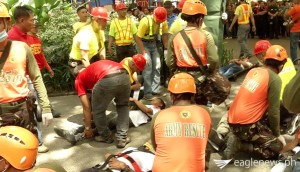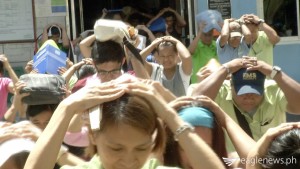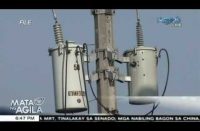
(Eagle News) — The metro-wide earthquake drill was a success with around six to seven million people participating in the “drop, cover and hold” exercise that was meant to prepare citizens for the so-called “Big One” – a 7.2 magnitude quake, according to the Metro Manila Development Authority.
Metro Manila, which has an estimated population of 11 million people, is the seat of government and considered the most populous region in the Philippines. It is also the seventh most populous metropolitan area in Asia.
The quake drill, led by the Metro Manila Development Authority (MMDA), started at 10:30 a.m. Thursday, July 30, and lasted for about 45 seconds to one minute..
All schools and government as well as private offices participated in the quake drill.
School administrators and government officials led the mock-quake evacuation procedures. Whistles were used by school children who have long been prepared for the metro-wide quake drill. They were instructed to “drop, cover and hold” while the quake drill lasted. There were also evacuation and rescue exercises.



The Philippine Institute of Volcanology and Seismology (Phivolcs) said as many as 34,000 people could die in case a 7.2 magnitude quake hits Metro Manila.
It had a joint study with the MMDA and the Japan International Cooperation Agency (JICA) where they looked at 18 earthquake scenarios, three scenarios of which were selected for detailed damage analysis. These scenarios are a 7.2-magnitude earthquake from the West Valley Fault, an offshore 7.9-magnitude earthquake from the Manila Trench and a 6.5-magnitude earthquake hitting Manila Bay.
The West Valley Fault is a 100-kilometer fault that runs through six cities in Metro Manila and nearby provinces. A 7.2 magnitude quake involving this fault is considered the worst-case scenario, and is called “The Big One.” If this quake lasts for 30 seconds, 34,000 people may die.
Another 114,000 individuals will be injured while 340,000 houses will be partly damaged, the study said.
The study also said that at least seven bridges will fall off while 10 percent of public buildings will be heavily damaged.
It is also predicted that 4,615 kilometers of water distribution pipes will suffer 4,000 points of breakage while 30 kilometers worth of electric cables will be cut and 95 kilometers of communication cables will be disconnected.
The damage will be greater in informal settlements or squatter areas, it said.
“The rapid urbanization of Metropolitan Manila has resulted in unsatisfactory infrastructure construction, poor housing condition, highly dense areas, and areas characterized by mixed land use and other inappropriate conditions. Thus, the potential for natural disaster in Metro Manila is high and the reduction of its vulnerability is a pressing issue for the safety of residents,” the Phivolcs study further said.
(Eagle News Service)







